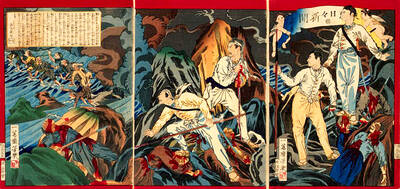It is a rare thing for an executive producer to receive a standing ovation in a theater, but Kenneth Pai’s production of the classic kun opera (崑劇) The Jade Hairpin (玉簪記) was, above all else, about his passion and new vision for this ancient operatic form.
On Friday, he brought an audience at the National Theater that ranged from high school kids to elderly opera aficionados to its feet when he appeared at the end of the curtain call. During the interval, Pai had been virtually mobbed by girls wearing the distinctive green-and-black uniforms of the Taipei Municipal First Girls’ Senior High School (北一女中), who were there in force.
Pai had set out to make kun opera chic and cool and just good plain fun: The Jade Hairpin achieved all of these. Pai’s new aesthetic for kun is difficult to pin down. There are no startling departures from convention. It is more about overall quality, a look, a knowing sophistication that immediately announced itself as something new and stylish.
From the opening sequence, the production values were evident in the sophisticated lighting, the simple, elegant set, the magnificently understated costumes and the discipline of the chorus line. Considerable attention to technical details, from the sound quality to the use of the follow spot, contributed to the overall effect, and this care is something that other local productions could learn from.
The two young stars, Shen Fengying (沈豐英) and Yu Jiulin (�?L), were in fine form, and despite the archaic manners of an opera style that dates back almost five centuries, they managed to prove that young love is a constant, however it is expressed.
In a scene in which the two young characters get to know one another other while playing the zither, their elaborate courtesies are a source of humor, but this never undermined the beauty of the music — provided by a Tang Dynasty zheng (箏) performed by Li Xiangting (李祥霆) — or the poetry of the lyrics. This balancing act was maintained throughout the nearly three-hour performance.
The show finished with a scene that combined complex choreographed movements to imitate, on an empty stage, a dangerous meeting on a turbulent river, and some passionate arias in which the love birds pledge their eternal love to each other.
One very small fly in the ointment was the quality of the English surtitles. Although superior to what is generally seen in the few traditional productions that sport English surtitles, the quality was uneven and certainly could have done with thorough editing.
Upstairs in the Experimental Theater, Lin Wen-chung’s (林文中) latest work, Small Songs, kept dancers rooted to a confined space, much like his WCdance troupe’s premiere piece, Small.
Instead of a Plexiglas cube, however, his design team came up with a rectangular platform.
Lin has made a virtue out of minimalism. He has a real flair for reducing the space and time needed to convey his ideas while giving you richly layered, finely nuanced works. His works bring to mind Persian miniatures, those small worlds that mix reality and dreams and become more complex the longer you look at them.
While Lin is capable of filling an entire stage, the score for Small Songs was an intriguing mix of songs by the Mexican-American singer Lhasa de Sela, P.S. I Love You from the film of the same name, Love You to Death from Cape No. 7 (海角七號), a nanguan (南管) piece, excerpts from Handel and Mozart and Song to the Moon from the Czech opera Ruslaka.
The latter was used in the segment titled “A song of Wenchung and Ruping” danced by Chiu Yu-wen (邱鈺閔) and Chang Chih-chieh (張智傑) that segued from a lovely pas de deux to a friendly but exhilarating competition. It was a beautiful and moving tribute by Lin to his wife, Wang Ru-ping (王如萍), a dancer with the Jose Limon Company.
Lin himself appeared just briefly, leaving most of the work to his five dancers, especially the exceptional Chiu and Lin Hsiao-yuan (林筱圓).
While “minimalism” was the word that sprang to mind with Lin Wen-chung, “articulated” seemed to be the word to define Wayne McGregor and his Random Dance company’s production Entity at Novel Hall on Friday night.
In McGregor’s choreography, the joints of the body — from the neck to the shoulders, elbows, hips, knees and ankles— are twisted and cocked to allow the body to turn in unexpected directions.
Like Lin, McGregor strips away all the excess, a minimalism reflected in the set by Patrick Burnier (who also designed the black briefs/white T-shirt costumes) — three screens held up (or down) by structures that look like catapult rigs.
Entity began and ended with a stop-motion short video projection made from photographs of a racing greyhound taken by 19th-century photographer Eadweard Muybridge. Just as Muybridge’s Animal Locomotion works allowed viewers to clearly delineate the movements of running animals, McGregor’s choreography takes apart his 10 dancers’ bodies and puts them back together in unexpected ways.
Friday’s show at Novel Hall was a fascinating introduction to one of the most innovative choreographers working today.

In the March 9 edition of the Taipei Times a piece by Ninon Godefroy ran with the headine “The quiet, gentle rhythm of Taiwan.” It started with the line “Taiwan is a small, humble place. There is no Eiffel Tower, no pyramids — no singular attraction that draws the world’s attention.” I laughed out loud at that. This was out of no disrespect for the author or the piece, which made some interesting analogies and good points about how both Din Tai Fung’s and Taiwan Semiconductor Manufacturing Co’s (TSMC, 台積電) meticulous attention to detail and quality are not quite up to

April 21 to April 27 Hsieh Er’s (謝娥) political fortunes were rising fast after she got out of jail and joined the Chinese Nationalist Party (KMT) in December 1945. Not only did she hold key positions in various committees, she was elected the only woman on the Taipei City Council and headed to Nanjing in 1946 as the sole Taiwanese female representative to the National Constituent Assembly. With the support of first lady Soong May-ling (宋美齡), she started the Taipei Women’s Association and Taiwan Provincial Women’s Association, where she

Chinese Nationalist Party (KMT) Chairman Eric Chu (朱立倫) hatched a bold plan to charge forward and seize the initiative when he held a protest in front of the Taipei City Prosecutors’ Office. Though risky, because illegal, its success would help tackle at least six problems facing both himself and the KMT. What he did not see coming was Taipei Mayor Chiang Wan-an (將萬安) tripping him up out of the gate. In spite of Chu being the most consequential and successful KMT chairman since the early 2010s — arguably saving the party from financial ruin and restoring its electoral viability —

It is one of the more remarkable facts of Taiwan history that it was never occupied or claimed by any of the numerous kingdoms of southern China — Han or otherwise — that lay just across the water from it. None of their brilliant ministers ever discovered that Taiwan was a “core interest” of the state whose annexation was “inevitable.” As Paul Kua notes in an excellent monograph laying out how the Portuguese gave Taiwan the name “Formosa,” the first Europeans to express an interest in occupying Taiwan were the Spanish. Tonio Andrade in his seminal work, How Taiwan Became Chinese,